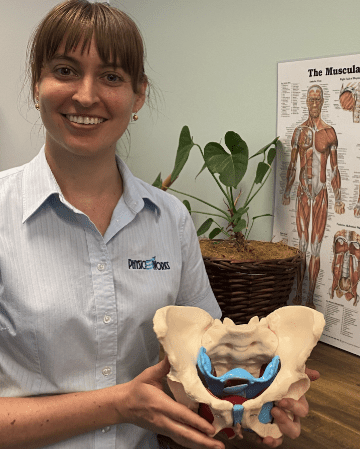Pelvic Floor Exercises
Article by Nadine Stewart
Pelvic Floor Exercises
What Are Your Pelvic Floor Muscles?
The pelvic floor consists of layers of muscle and tissue stretching from the tailbone to the pubic bone. In women, these muscles support the bladder, womb, and bowel, playing a crucial role in bladder and bowel control and sexual sensation. For men, a strong pelvic floor is equally important, especially for those with specific health conditions.

Female Pelvic Floor
A woman’s pelvic floor supports the bladder, the womb (uterus) and the bowel. The urethra (front passage), the vagina (birth canal) and the rectum (back passage) pass through the pelvic floor muscles. The pelvic floor muscles play an important role in bladder and bowel control and sexual sensation.
Male Pelvic Floor
A healthy pelvic floor muscle is equally important for men. It is just as vital for men to be encouraged to exercise their pelvic floor muscles, especially for men with specific health conditions.
Signs of a Weak Pelvic Floor
Weak pelvic floor muscles can result from:
- Pregnancy and childbirth
- Straining during bowel movements (constipation)
- Persistent heavy lifting
- Chronic cough (from smoking, bronchitis, or asthma)
- Being overweight
- Hormonal changes during menopause
- Surgery (such as prostate surgery or episiotomy)
- Weak core muscle strength
- Lack of general fitness
Benefits of Pelvic Floor Exercises
Pelvic floor exercises benefit everyone, regardless of age or gender. These exercises are particularly useful for those experiencing stress incontinence, where urine is involuntarily released during activities like coughing, sneezing, or exercising. For pregnant women, strong pelvic floor muscles support the increasing weight of the baby and aid in recovery after birth. As women age, maintaining these muscles helps mitigate the effects of menopause on pelvic support and bladder control. Men also benefit from these exercises, particularly as they age.
Additionally, pelvic floor exercises can complement a bladder training program to improve bladder control in those with urge incontinence, where there is a frequent and urgent need to urinate.
Testing Your Pelvic Floor Muscles
To test your pelvic floor muscles:
- Sit or lie down with relaxed thigh, buttock, and abdominal muscles.
- Tighten the ring of muscle around the back passage as if trying to control diarrhoea or wind. Relax it. Repeat until confident you are exercising the correct muscle.
- When urinating, try to stop the flow mid-stream, then restart it. Only do this once a week to check progress, as it may interfere with bladder emptying.
If you can’t feel a definite squeeze and lift, seek professional help. A physiotherapist or continence advisor can prescribe exercises to get your pelvic floor muscles working correctly. Most cases can be treated without internal examination.
Performing Pelvic Floor Exercises Correctly
A physiotherapist with special training in pelvic floor conditions can assist in training your pelvic floor muscles effectively. They will:
- Assess your pelvic floor function
- Diagnose conditions like urge or stress incontinence
- Identify the correct muscle contraction
- Provide home exercises and guidance
- Offer real-time ultrasound physiotherapy to assist retraining
Where to Seek Help
Consult a physiotherapist specialising in pelvic floor rehabilitation. With their guidance, you can strengthen your pelvic floor muscles effectively. Consistent effort and professional advice will yield the best results.
Tips for Protecting Your Pelvic Floor
To avoid stressing your pelvic floor, consider these tips:
- Share heavy lifting
- Prevent constipation and straining during bowel movements
- Seek medical advice for chronic coughs from hay-fever, asthma, or bronchitis
- Maintain a healthy weight
Conclusion
Strengthening your pelvic floor muscles is vital for overall health and well-being. These exercises can improve bladder and bowel control and support sexual health. Whether you’re dealing with stress incontinence, preparing for childbirth, or aiming to maintain muscle strength as you age, pelvic floor exercises are essential.
What to Do?
If you experience symptoms of a weak pelvic floor, consult your physiotherapist. They can provide a tailored exercise plan to help you achieve the best results.
Rochedale - Call 38410277
Book Online: RochedaleSalisbury - Call 32751044
Book Online: SalisburySandgate - Call 32691122
Book Online: SandgatePelvic Floor Exercises FAQs
1. What are pelvic floor exercises? Pelvic floor exercises strengthen the muscles that support the bladder, bowel, and, in women, the womb.
2. How do I know if I need pelvic floor exercises? Signs include stress incontinence, frequent urination urges, and post-pregnancy recovery needs. Consult a physiotherapist for an assessment.
3. Can men benefit from pelvic floor exercises? Yes, men benefit greatly, particularly those with incontinence or after prostate surgery.
4. How long does it take to see results from pelvic floor exercises? Results can vary, but with regular practice, improvements can be seen in a few weeks to months.
5. Are there any risks associated with pelvic floor exercises? When done correctly, there are minimal risks. Incorrect technique may not yield benefits, so professional guidance is recommended.
6. How often should I do pelvic floor exercises? Aim for daily exercises. Your physiotherapist can provide a specific plan tailored to your needs.
Related Articles
- Male Pelvic Floor Exercises: A Physiotherapist’s Insights – Provides insights into strengthening the male pelvic floor, highlighting its importance for men’s health and wellbeing.
- Underactive Pelvic Floor – Discusses conditions related to an underactive pelvic floor and the significance of exercises for improvement.
- Pre & Post Prostatectomy Rehab – Highlights the importance of pelvic floor exercises before and after prostate surgery for men, aiming at faster recovery and better control.
- Pregnancy Exercises: Safe Workouts For Expectant Mothers – While not directly linked, this article includes pelvic floor strengthening as a crucial aspect of pregnancy exercises.
- Pelvic Floor Conditions – Addresses various conditions affecting the pelvic floor, underscoring the role of targeted exercises in management and recovery.
- Women’s Health Physiotherapy Conditions – Address a range of women-specific concerns, including pelvic floor issues.
- Constipation Management – Find ways to manage constipation, which can impact pelvic floor health.
- Faecal Incontinence – Understand the role of pelvic floor exercises in managing faecal incontinence.
- Mastitis/Blocked Ducts – Learn about mastitis and blocked ducts, with tips for managing these conditions.
- Stress Incontinence – Explore treatments and exercises for managing stress incontinence.
Each link provides detailed information to support your pelvic floor health journey.





